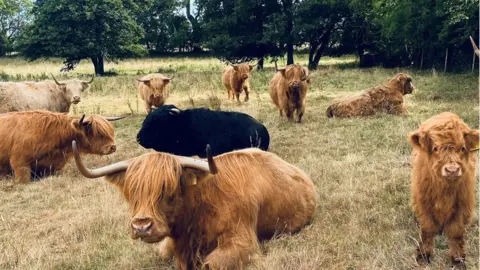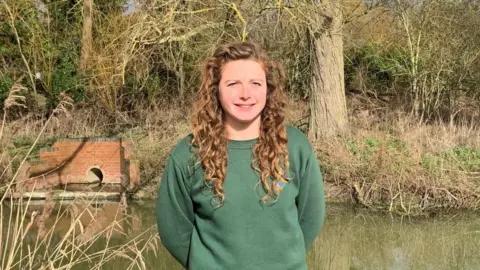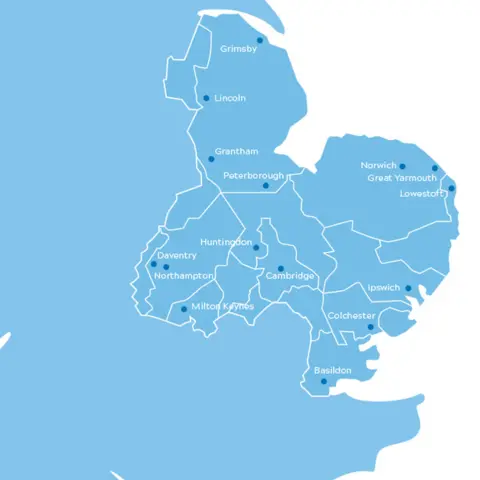East of England faces drought, says water firm
 Tim Addicott/BBC
Tim Addicott/BBCThe East of England faces a probable drought this summer after winter rainfall was not as heavy as required.
Anglian Water said the area remained in "drought status" despite it seeing a roughly average amount of rainfall in recent months.
The service provider said while its reservoirs had recovered, groundwater sources, especially in north Norfolk, were well below normal levels.
It said more rain was needed to offset the issue after last summer's drought.
Some farmers and environmentalists say the situation has been exacerbated by a drier February than normal.
Anglian Water confirmed a hosepipe ban was not out of the question.
"These areas rely mainly on groundwater levels for their water supply, but have only seen around 80% of the long-term rainfall over the last 12 months," the company explained.
"Following such a dry summer last year, it's not been enough yet to filter through the ground and bolster supplies, meaning these underground reserves still have a deficit of around 1.5 months' worth of rain."
Summer 'deficit'
The company added: "If we don't get the predicted rainfall over the next couple of months before spring, we may still need to consider temporary restrictions this year in some areas."
Weather forecaster Dan Holley of Weatherquest agreed the required wet winter had not materialised.
"We haven't really made too much of a dent on that deficit that we had last summer," he said.
"We really need some rain going forward as we head into drier parts of this year."
 Cambridge University Botanic Garden
Cambridge University Botanic GardenLast year's rainfall averaged 76% of expected precipitation levels, said Mr Holley.
In January, East Anglia saw 91% of expected rainfall, but according to the weather forecaster, February has been an incredibly dry month.
"Things like soil moisture and river flow and groundwater are notably or exceptionally low so we need rain in March," said Mr Holley.
Izzi Rainey, 30, farms highland cattle at Bates Moor Farm in Foulsham, near Dereham, and agrees this "February is probably the driest its ever been".
"We actually haven't had a decent amount of rain for the last three weeks," she said.
 Izzy Rainey
Izzy RaineyMs Rainey said normally in winter, she could not take heavy machinery on to the clay meadows "because they're so boggy they just turn into a swamp".
But she added: "Right now I'm in the middle of fencing the whole farm, and I thought I wouldn't be able to get going until at least March but we've been driving on the meadows in teleporters to pull fences out, because [the meadows are] so dry."
Ms Rainey, who has native cattle, said her herd should be able to live outside from April until October or November without additional feed.
But last year, she said, she was having to spend between £400 and £500 a week on feed during the dry summer. "The whole thing was just cost ineffective," she explained.
She said she then decided to move her cattle nearer her home, and grew hay on land she rented to ensure a supply of food for them, as well as reduce fuel costs in transporting the hay to the cows.
 Tim Addicott/BBC
Tim Addicott/BBCEmily Winter, from the River Waveney Trust on the Norfolk/Suffolk border, said she was concerned about the river's low levels and the lack of rainfall going forward.
She said: "If we compare to this time last year, flows were seven times greater.
"We would normally expect much more water, higher river levels, potentially even flooding of the marshland surrounding us."
The river level now was "typical of a summer flow", she added.
A low flow would affect the oxygen levels of the water, impacting on its aquatic plants and insects and larger creatures like fish.
"Potentially, species would be lost," Ms Winter said. "The low levels also meant the river could not be used for recreation activities."
She said the lack of rainfall was a concern for the whole of the East of England.
 Anglian Water
Anglian Water
Find BBC News: East of England on Facebook, Instagram and Twitter. If you have a story suggestion email [email protected]
